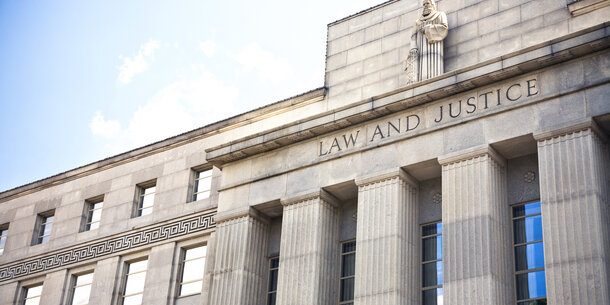State courts, and particularly state supreme courts, are on the front lines of high-stakes controversies with national implications — from abortion rights to gerrymandered maps to climate policies. 1 Typically, state high courts have the final say on questions of state law. 2 In the coming years, these courts are likely to take on even greater importance as the federal judiciary shuts its doors to litigation involving fundamental rights.
Thirty-eight states elect their high court judges. 3 These elections — once relatively low cost and quiet — have become more expensive and partisan, increasingly looking like races for political office. In 2021–22, candidates, interest groups, and political parties spent more than $100 million on state supreme court elections, nearly twice as much as in any prior midterm cycle. 4 Wisconsin’s 2023 high court election, which brought a liberal majority to the bench for the first time in 15 years, saw more than $50 million in spending. 5
As spending in judicial elections has ballooned, it has also grown secretive. In the 14 years since the U.S. Supreme Court handed down Citizens United v. Federal Election Commission (2010), special interests have channeled more of their spending through super PACs and 501(c)(4) nonprofits, which can raise and spend unlimited amounts of money without disclosing their donors, rather than contributing to the candidates themselves. 6 Recent U.S. Supreme Court rulings, such as Dobbs v. Jackson Women’s Health Organization (2022), have led to a surge of high-profile state court litigation, accelerating these trends. 7
Today, outside groups are largely unregulated by state campaign finance laws and pose specific challenges with respect to judicial elections:
- Lack of transparency. Much of the spending comes from outside groups that are cagey about the true sources of their funding. For example, in the 2015–16 supreme court election cycle, only 18 percent of expenditures could be traced to easily identifiable donors. 8 This leaves voters in the dark and creates the potential for unseen conflicts of interest when judges hear cases involving major campaign supporters.
- Coordination with candidates. Weak state regulations enable groups to sidestep contribution limits by coordinating their spending with their favored candidates behind the scenes. Judicial candidates regularly collaborate with outside groups on supportive ads. 9 Candidates have also been accused of relying on groups to serve basic campaign functions, such as raising money, mobilizing voters, and hosting candidate forums. 10 Coordinated spending allows candidates to benefit from groups’ support while evading campaign finance and ethics rules.
- Failures to recuse. Elected judges regularly hear cases involving major campaign supporters, and such conflicts of interest can skew judicial decision-making. 11 While almost every state requires judges to step aside from cases when their “impartiality might reasonably be questioned,” few offer guidance about when campaign contributions by litigants or their lawyers require recusal, and even fewer address independent expenditures. 12 Further, in most states with elected courts, judges facing motions for recusal are allowed to decide for themselves whether recusal is warranted, without any independent review. 13
State legislatures have generally failed to codify stronger disclosure standards or close coordination loopholes. Nor have they strengthened judicial recusal rules or ethics standards. 14 With high-cost state supreme court elections likely here to stay, another mechanism can mitigate the growing influence of outside spending in judicial elections: reforms to judicial ethics rules, which govern the behavior of judicial candidates (including sitting judges running for reelection), and to procedural court rules, which govern court proceedings.
Most state high courts have the power to amend state judicial ethics rules, procedural court rules, or both. To that end, we offer model rules in the appendix that would
- establish clear standards for when election spending — including direct contributions, independent expenditures, spending that was coordinated with a candidate or their campaign, and contributions to outside groups or political parties that spent in connection with a judge’s election — requires recusal;
- provide for independent consideration of recusal requests;
- prohibit judicial candidates and their campaigns from coordinating with outside groups; and
- require litigants and lawyers to disclose any election spending that they, their counsel, or associated donors made in support of or against the judge assigned to their case or a candidate who opposed the judge.
The model rules in this report are informed by the Brennan Center’s research on spending in judicial elections, recusal standards, and judicial ethics. 15 They are also informed by extant rules and can be modified to account for jurisdiction-specific needs. 16 Because the Model Code of Judicial Conduct promulgated by the American Bar Association (ABA) is the primary template for states’ judicial ethics rules, we propose revisions to the ABA’s model code as the basis for our model ethics rules. 17
Endnotes
-
1
For recent state constitutional cases across the country, see “State Case Database,” State Court Report, https://statecourtreport.org/state-case-database.
-
2
Douglas Keith, Patrick Berry, and Eric Velasco, The Politics of Judicial Elections, 2017–18, Brennan Center for Justice, 2019, 2, https://www.brennancenter.org/sites/default/files/2019–12/2019_11_Politics%20of%20Judicial%20Elections_FINAL.pdf.
-
3
Brennan Center for Justice, “Judicial Selection: An Interactive Map,” last updated October 11, 2022, https://judicialselectionmap.brennancenter.org/.
-
4
This calculation reflects adjustments for inflation. Douglas Keith, The Politics of Judicial Elections, 2021–22, Brennan Center for Justice, 2024, https://www.brennancenter.org/our-work/research-reports/politics-judicial-elections-2021–2022.
-
5
Keith, The Politics of Judicial Elections, 2021–22.
-
6
In Citizens United, the U.S. Supreme Court struck down limits on election spending by corporations and unions, as long as it is done independently of candidates. Citizens United v. Federal Election Commission, 558 U.S. 310 (2010). Lower courts have interpreted Citizens United to likewise prohibit states from limiting contributions to groups that do not coordinate with candidates and political parties. See SpeechNow.org v. Federal Election Commission, 599 F.3d 686 (D.C. Cir. 2010).
-
7
In Dobbs, the U.S. Supreme Court held there is no constitutional right to abortion, overturning Roe v. Wade. Dobbs v. Jackson Women’s Health Org., 597 U.S. 215 (2022).
-
8
Alicia Bannon, Cathleen Lisk, and Peter Hardin, Who Pays for Judicial Races?, Brennan Center for Justice, 2017, 2, https://www.brennancenter.org/sites/default/files/publications/Politics_of_Judicial_Elections_Final.pdf.
-
9
For example, in 2018 a liberal group called Greater Wisconsin Committee spent $352,235 on an ad supporting then Wisconsin Supreme Court candidate Rebecca Dallet that used portions of B-roll appearing on the Dallet campaign’s YouTube account. Rebecca Dallet for Justice, “Extras,” YouTube, February 28, 2018, video, 2:46, https://www.youtube.com/watch?v=EqSfFoB5-cQ; Greater Wisconsin Political Fund, “At It Again,” March 28, 2018, video, 0:28, https://www.brennancenter.org/sites/default/files/STSUPCT_WI_GREATERWI_AT_IT_AGAIN.wmv; and Brennan Center for Justice, “Buying Time 2018 – Wisconsin,” January 23, 2018, https://www.brennancenter.org/our-work/research-reports/buying-time-2018-wisconsin.
-
10
Alison Frankel, “Behind $250 Million State Farm Settlement, a Wild Tale of Dark Money in Judicial Elections,” Reuters, September 5, 2018, https://www.reuters.com/article/legal-us-otc-darkmoney/behind-250-million-state-farm-settlement-a-wild-tale-of-dark-money-in-judicial-elections-idUSKCN1LL2ZQ; “Elections Board Cites Wilcox’s Campaign Manager, Voter Group,” Daily Reporter, July 25, 2000, https://dailyreporter.com/2000/07/25/elections-board-cites-wilcox8217s-campaign-manager-voter-group/; and “State Authorities Launch Investigations into Mark Walker, E.C. Sykes and the ‘Alliance Defending Freedom,’” Carolina Forward, February 27, 2023, https://carolinaforward.org/blog/investigation-into-walker-sykes-alliance-defending-freedom/.
-
11
Alicia Bannon, Choosing State Judges: A Plan for Reform, Brennan Center for Justice, 2018, 4, https://www.brennancenter.org/our-work/policy-solutions/choosing-state-judges-plan-reform.
-
12
The “impartiality might reasonably be questioned” standard comes from the ABA’s model recusal rule. ABA Model Code of Judicial Conduct, Model Rule 2.11(A). Wisconsin’s recusal rule explicitly provides that judges “shall not be required” to recuse themselves solely on the basis of campaign contributions. Wis. R. App. P. CJC S 60.04(7).
-
13
Matthew Menendez and Dorothy Samuels, Judicial Recusal Reform: Toward Independent Consideration of Disqualification, Brennan Center for Justice, 2016, 4–5, https://www.brennancenter.org/sites/default/files/2019–08/Report_Judicial_Recusal_Reform.pdf.
-
14
There is technically a difference between disqualification, which is mandatory, and recusal, which is voluntary; however, that difference is often blurred in practice because disqualification can function like recusal in jurisdictions where judges can decide for themselves whether they must step aside from a case. In this report, we use the terms interchangeably but distinguish between voluntary and mandatory recusal.
-
15
Bannon, Choosing State Judges; Menendez and Samuels, Judicial Recusal Reform; and Adam Skaggs and Andrew Silver, Promoting Fair and Impartial Courts Through Recusal Reform, Brennan Center for Justice, 2011, https://www.brennancenter.org/sites/default/files/2019–08/Report_Promoting_Fair_Courts_2011.pdf.
-
16
Sources include existing state and local laws, state judicial ethics rules, state court rules, and previously proposed revisions to Rule 2.11 of the ABA’s model code.
-
17
See Tom Lininger, “Green Ethics for Judges,” George Washington Law Review 86 (July 30, 2018): 720, https://www.gwlr.org/green-ethics-for-judges/ (noting that “the vast majority of states have adopted approximately ninety percent of the provisions in the ABA’s boilerplate”).




